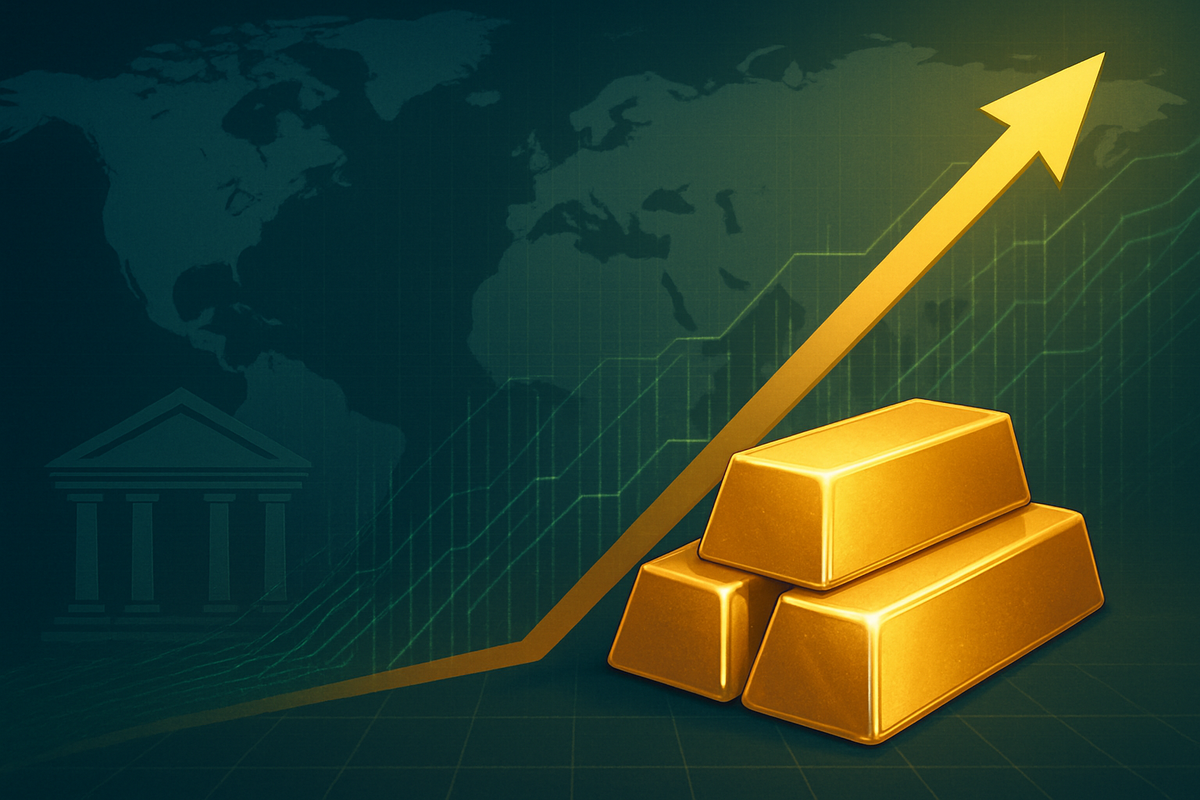
In a significant revision that has sent ripples through the global financial markets, investment banking giant Goldman Sachs (NYSE: GS) has dramatically raised its gold price target to an unprecedented $4,900 per ounce by December 2026. This bullish forecast, a substantial increase from its previous projection of $4,300, underscores a profound shift in market dynamics, driven primarily by an insatiable appetite from Exchange Traded Funds (ETFs) and sustained, strategic purchasing by central banks worldwide. The announcement solidifies the prevailing bullish sentiment surrounding the precious metal, which has already witnessed a remarkable 51% surge in 2025, consistently hitting new all-time highs and positioning gold as one of the year's top-performing assets.
This updated outlook from Goldman Sachs is not merely a numerical adjustment; it represents a comprehensive re-evaluation of gold's role in the current economic and geopolitical landscape. The bank's analysts point to a 'new paradigm' for gold prices, suggesting that traditional investment models may need recalibration. For investors, this signals a reinforced call to reassess portfolio allocations, with gold's inherent value as a hedge against inflation, currency debasement, and market volatility becoming increasingly prominent in a world grappling with economic uncertainties and evolving geopolitical tensions.
Unpacking the Gold Rush: ETFs, Central Banks, and Macroeconomic Tailwinds
Goldman Sachs' revised forecast is built upon several pillars of robust demand and favorable macroeconomic conditions. At the forefront are the significant inflows into gold-backed Exchange Traded Funds (ETFs) and the unwavering accumulation by global central banks, particularly those in emerging markets.
The resurgence of Western gold ETF demand has been a critical factor. September 2025 alone witnessed an astonishing $17.3 billion in ETF inflows, marking the largest monthly gain in history, contributing to a staggering $64 billion in total inflows through September. Global gold ETF holdings now stand at 3,692 tonnes, nearing their all-time record. This renewed interest from Western investors, after years of outflows, is seen by Goldman Sachs as a fundamental shift, indicating that this demand is not an anomaly but a sustained trend. These "conviction buyers" are expected to continue driving price direction through consistent purchases, irrespective of short-term price fluctuations.
Concurrently, central banks continue their strategic diversification away from traditional reserve currencies like the U.S. dollar, with gold becoming a cornerstone of their reserve management strategies. Goldman Sachs projects central bank gold purchases to average 80 metric tons per month in 2025 and 70 metric tons per month in 2026. This structural shift, intensified since 2022, reflects a broader geopolitical and economic rebalancing, with emerging market institutions leading the charge to fortify their reserves with the tangible security of gold.
Adding further impetus to gold's ascent are expectations of U.S. Federal Reserve interest rate cuts. Goldman Sachs analysts anticipate a 100-basis-point reduction in the funds rate by mid-2026. Lower real yields diminish the opportunity cost of holding non-yielding assets like gold, making it more attractive to investors. A weaker U.S. dollar, a typical consequence of declining interest rates, further enhances gold's appeal as a safe-haven asset. Moreover, the bank highlights the potential for private sector diversification into the relatively small gold market, especially amidst heightened geopolitical risks and a potential erosion of trust in institutional frameworks. A scenario where the Federal Reserve's independence is compromised, for instance, could propel gold prices even closer to the $5,000 mark.
Companies Poised to Win or Lose in the Golden Era
A sustained surge in gold prices to Goldman Sachs' projected $4,900 will undoubtedly create significant winners and losers across various sectors, particularly within the mining industry and financial markets.
Gold mining companies, especially those with established operations and strong production profiles, stand to be major beneficiaries. Companies like Barrick Gold Corporation (NYSE: GOLD), Newmont Corporation (NYSE: NEM), and Agnico Eagle Mines Limited (NYSE: AEM) could see substantial increases in their revenues and profit margins. Higher gold prices directly translate to improved profitability per ounce extracted, allowing miners to fund exploration, expand existing operations, or return capital to shareholders through dividends and buybacks. Junior exploration companies with promising undeveloped gold reserves may also experience increased investor interest and valuations as the economics of new projects become more favorable. However, companies with high operating costs or significant debt might still face challenges, even in a high-price environment, if they cannot efficiently scale production or manage their financial leverage.
Conversely, certain sectors might face headwinds. Industries heavily reliant on gold as a raw material, such as jewelry manufacturers and some electronics producers, could see increased input costs, potentially squeezing their margins or forcing them to pass on higher prices to consumers, which could impact demand. Companies like Tiffany & Co. (NYSE: TIF) (a subsidiary of LVMH Moët Hennessy Louis Vuitton SE, Euronext: MC) or other luxury goods brands might need to adjust their pricing strategies or explore alternative materials if gold's ascent becomes too steep. Furthermore, financial institutions with significant short positions in gold or those that have misjudged the precious metal's trajectory could face losses. Investment firms specializing in alternative assets or commodities, however, could see increased inflows into their gold-focused funds.
The broader implications extend to the investment management industry. Asset managers offering gold-backed ETFs, such as SPDR Gold Shares (NYSEARCA: GLD) and iShares Gold Trust (NYSEARCA: IAU), are likely to experience continued growth in assets under management (AUM) and corresponding fee income. This environment also encourages innovation in gold investment products, potentially leading to new derivatives or structured products designed to capitalize on the bullish trend.
The Wider Significance: A New Monetary Paradigm?
Goldman Sachs' audacious gold price target extends beyond a mere commodity forecast; it signals a potentially transformative shift in global financial architecture and investment philosophy. This event fits squarely into broader industry trends emphasizing diversification, de-dollarization, and a heightened focus on tangible assets amidst persistent economic uncertainty and geopolitical fragmentation.
The consistent central bank buying, particularly from emerging economies, highlights a growing sentiment of distrust in the current U.S. dollar-centric global reserve system. This strategic accumulation of gold is a tangible manifestation of a desire for greater monetary autonomy and a hedge against potential currency volatility or sanctions. It represents a long-term, structural rebalancing of global reserves, a trend that could have profound ripple effects on the U.S. dollar's status and the international financial system. If more nations follow suit, the demand for gold could become even more inelastic, pushing prices higher than even current bullish forecasts.
The robust ETF inflows, especially from Western investors, suggest a return of retail and institutional confidence in gold as a legitimate investment asset and a hedge against inflation and market instability. This is a significant departure from periods where gold was often overlooked in favor of high-growth equities or interest-bearing assets. The renewed interest underscores a recognition of gold's historical role as a store of value, particularly in an environment where inflation remains a concern and geopolitical tensions are escalating. This broader acceptance could lead to increased mainstream adoption of gold as a portfolio diversifier, further solidifying its price floor.
Regulatory bodies and policymakers will be closely watching these developments. A rapidly rising gold price, especially if driven by a flight from fiat currencies, could spark discussions around monetary policy, inflation targeting, and the stability of the global financial system. While there are no immediate regulatory implications specific to Goldman Sachs' forecast, a prolonged and significant gold rally could prompt central banks to re-evaluate their own reserve strategies and potentially influence international financial agreements. Historically, periods of significant gold price appreciation have often coincided with economic instability or periods of high inflation, serving as a barometer of investor confidence in traditional financial assets.
What Comes Next: Navigating the Golden Path Ahead
The path to Goldman Sachs' projected $4,900 gold price by December 2026 presents a fascinating landscape of short-term volatility and long-term strategic adjustments for market participants. In the immediate future, gold prices are likely to continue their upward trajectory, albeit with periodic corrections as investors take profits. The conviction buying from central banks and ETFs is expected to provide a strong underlying support, mitigating severe downturns. Investors should closely monitor Federal Reserve pronouncements regarding interest rates, as any deviation from the expected rate cut path could introduce short-term headwinds for gold.
In the long term, the structural drivers identified by Goldman Sachs—persistent central bank demand and sustained ETF inflows—suggest a new, higher equilibrium for gold prices. This environment creates significant market opportunities for gold producers to expand their operations, for exploration companies to discover new deposits, and for financial institutions to innovate new gold-backed investment products. Asset managers focused on commodities and precious metals are likely to see continued growth in their funds. However, challenges may emerge for industries sensitive to rising raw material costs, necessitating strategic pivots such as cost optimization, hedging strategies, or product diversification.
Potential scenarios include an accelerated rally if geopolitical tensions escalate further or if there is a more rapid erosion of confidence in major fiat currencies, pushing gold towards or even beyond the $5,000 mark. Conversely, a stronger-than-expected economic recovery globally, coupled with a more hawkish stance from central banks, could temper gold's ascent. However, Goldman Sachs believes the risks to its upgraded forecast are skewed to the upside, implying that the factors driving the rally are robust and potentially underestimated. Investors should consider gold's role as a strategic asset for portfolio diversification, a hedge against inflation, and a safe haven during times of uncertainty.
A Golden Future: Market Reassessment and Lasting Impact
Goldman Sachs' revised gold price target of $4,900 by December 2026 is a pivotal moment in the ongoing narrative of the precious metal, signaling a profound reassessment of its value and role in the global financial system. The key takeaways from this event are clear: gold's rally is not merely speculative but driven by fundamental, structural shifts in demand from powerful institutional players—central banks seeking diversification and ETF investors seeking safety and inflation hedges.
Moving forward, the market is likely to operate under a new paradigm where gold commands a higher baseline valuation. Its enduring appeal as a store of value, particularly in an era of heightened geopolitical risks and persistent inflation concerns, has been significantly reinforced. This forecast suggests that gold will continue to be a critical component of diversified investment portfolios, offering a robust hedge against currency debasement and market volatility. The implications extend beyond investors to policymakers, who will need to contend with the broader ramifications of a sustained shift towards gold as a reserve asset.
Investors should watch for continued trends in central bank purchasing data, global ETF flows, and the trajectory of U.S. interest rates and the dollar. Any acceleration or deceleration in these drivers will provide crucial insights into gold's short-to-medium term performance. Furthermore, monitoring geopolitical developments and their impact on market sentiment will be essential. Goldman Sachs' bullish call underscores a belief in gold's lasting significance and its potential to deliver substantial returns for those who recognize its evolving role in an uncertain world.
This content is intended for informational purposes only and is not financial advice


















